


Text, photos and video by Tom Hintz
Test flying by Tom Hintz & Mike Basmajian
Flight video by Clark Ponthier
Posted – 7-13-2016
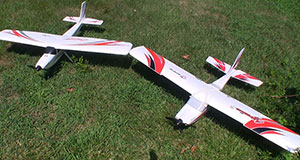
Not surprisingly FlyingRC.net gets lots of email asking what is the best RC trainer. What did surprise me is the number of people who asked about two specific planes. We have seen a number of these trainers at our flying field so a side-by-side review seemed to be the logical way to go. This Review will focus on the Apprentice® S 15e RTF with SAFE® Technology from Horizon Hobby and the Flyzone Sensei FS EP Trainer ARF w/WISE Gyro sold by Tower Hobbies. We were not able to get a fully RTF Sensei package that included the radio so I am going to use a Spektrum DX8 and a Spektrum AR6210 receiver to make the Sensei “ready to fly”. To keep the comparison on an even plane the DX8 will be programmed to use only the basic functions available in the Apprentice® S 15e RTF system. No dual rates, expo or other enhancements will be enabled in the DX8 for the Sensei.
Another thing I liked about comparing these planes is that both have stabilization systems with very similar capabilities purported to help the rank beginner learn to fly safely. In this review we will look at the stability systems to see how they work. In the near future we will do a more detailed “thrash” of these stability systems to look for their strong and weak spots – if any – that apply to the student pilot.
Throughout the testing and evaluation of these trainers Mike Basmajian will pilot the Apprentice® S 15e and I will fly the Flyzone Sensei FS. Having one pilot focusing on one plane will give us a more complete look at these trainers and how the stabilization systems apply to their flying characteristics.
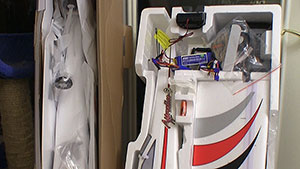
Both planes were bought new from their major distributors. The Apprentice® S 15e from Horizon Hobby and the Flyzone Sensei FS from Tower Hobbies. When the planes were ordered Tower was out of the Ready To Fly version so we purchased the Receiver Ready kit (#LXEXZM) and ordered compatible batteries and extra props at the same time.
I began work on the Flyzone Sensei FS by installing a Spektrum AR6210 receiver and bound it to a Spektrum DX8 transmitter to make it RTF (ready to fly) like the Apprentice® S 15e. The DX8 has many features not available on the DX5e included with the Apprentice® S 15e so none of those features will be enabled in the DX8 to keep the radios on an even playing field.
The Apprentice® S 15e is made from Z-Foam™ while the Flyzone Sensei FS is molded from AeroCell foam. These materials are reasonably similar and have similar strengths. Both tend to break with jagged, complex edges that make repairing with epoxy easy to do. The complex breaks mean that the pieces “index” insuring an accurate alignment that helps maintain the flying performance after the repair.
The Apprentice® S 15e has a wingspan of 59”, is 42-1/2” long and weighs 49 ounces or just over 3lbs. It uses a 15-size, 840Kv motor running on a single 3S, 3200mAh (1 pack included). A 30-Amp brushless electronic speed control (ESC) with built in BEC is pre-installed. A 12V only 2-3S LiPo balancing charger is included as is a Spektrum DX5e transmitter.
The Flyzone Sensei FS EP Trainer is made from AeroCell foam with a wingspan of 58", is 48" long and weighs 3.2lbs. The Flyzone Sensei FS has a brushless outrunner motor powered by a 3S 2200mAh LiPo battery.

Both the Apprentice® S 15e and Flyzone Sensei FS are equipped with built-in stabilization systems advertised to make learning to fly safer. It is important to note that while these systems do seem to help the novice learn to fly they do not remove the threat of a crash entirely. In both systems, even if they are able to right the plane and return it to straight and level flight before it hits the ground neither have the GPS capabilities needed to return the plane to the area of the pilot. I have trained pilots for decades and a common problem for nearly all of them in the early learning process is letting the plane get too far out or away from the pilot entirely. Neither of these stabilization systems can prevent this.
I have been in the woods near our flying field three separate times looking for two Apprentice® S 15e and one . The new pilots of all three felt they had used the “save” switch but their planes continued and flew out into the woods and crashed. We simply cannot expect an inexperienced pilot to fly the plane back from even reasonably great distances. An instructor is still needed, at least until the new pilot learns the basic skills to keep these stabilization-equipped planes as safe as possible.
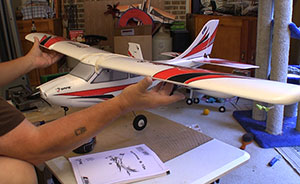
Beginners Mode allows approximately 15 degrees of up and down pitch and left and right roll. Let go of the sticks and the Apprentice® S 15e RTF returns to level flight. Beginners Mode also includes automatic assistance on takeoff and landings and we will look at these features more closely later during testing.
Intermediate Mode is similar to Beginners Mode but allows 90 degrees of pitch and roll rate to let the pilot be more aggressive with the plane while preventing it from going inverted. Once again, release the sticks and the Apprentice® S 15e returns to straight and level flight if it is at sufficient altitude.
Experienced Mode removes control limits allowing the pilot to loop, roll or fly inverted without interference of the stabilization system. The basic stabilization remains in effect, smoothing flight in all of the modes.
Panic Mode is available in all of the flight modes. If the plane gets out of control the pilot simply engages the Panic switch and holds it until the plane is flying level again. While the automated recovery is surprisingly quick the Apprentice® S 15e RTF with SAFE® Technology needs a bit of altitude to complete the recovery without hitting the ground.
In the Beginner and Intermediate modes the WISE system limits the amount of pitch and roll allowed very much like the Apprentice® S 15e system regardless of how far the sticks are moved. And, in Beginner and Intermediate modes the system returns the plane to straight and level flight when the sticks are returned to center. In the Advanced mode the pilot has full control, can do loops and rolls and the system will not return the plane to level when the sticks are released.
When pulled the Bailout Switch overrides the sticks entirely and returns the plane to straight and level flight regardless of its orientation. The Flyzone Sensei FS Bailout function is available in all flight modes. If the Bailout switch is held for more than five seconds it “times out” and the sticks once again become active in the mode selected.
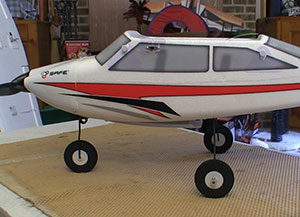
Both planes feature tricycle landing gear long favored on trainers because they steer more easily and eliminate having to “fly” the tail on tail dragger's. However, there are liabilities to having steerable nose wheel. One of the common mistakes new pilots make, usually several times, is landing with a slight nose-down attitude that can deliver a major shock to the nose wheel. That force on the nose gear can require re aligning the nose wheel or having to straighten the wire strut holding the wheel.
The Apprentice® S 15e has a removable cowl that exposes the area around the nose wheel gear to make repairs and adjustments relatively simple. For some reason the folks designing the Flyzone Sensei FS used a glued-on foam cowl with a small hole through which you can reach only the locking screw on the lower (vertical) positioning collar of the front wheel strut. You can see, but not reach the set screw on the steering arm to make adjustments. Virtually any damage or alignment issues mean that the cowl has to be cut apart to expose the nose wheel components or to service the motor and its mount and a new cowl installed. I think that this is an un necessary complication of an airplane specifically designed for pilots that are new to the hobby.
When I wrote this (7-7-2016) I checked for a replacement cowl on the Tower Hobbies site and had to use their sites search system to find it because it did not come up in the parts listing, possibly because it was out of stock and not due in until late July (2016) with a price of $16.99. This isn’t one of the Flyzone Sensei FS better qualities.
The Flyzone Sensei FS uses aluminum main gear while the Apprentice® S 15e has relatively heavy wire holding the main wheels. Both are capable of absorbing reasonably hard landings and both can be straightened to fly again. Both planes get a thumbs up for their main landing gear.
The Apprentice® S 15e and Flyzone Sensei FS come out even on the tail feathers as well. Both are modular, using bolt in easy to replace pieces that should keep the money down if you tear something up. Both designs fly well and have more than adequate response.
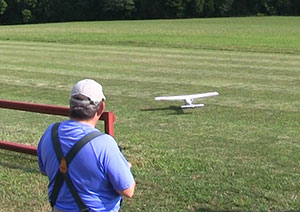
Both planes have two-piece wings to keep the size of the shipping box within reason. Both planes use a flat-bottomed wing profile with a bit of dihedral to enhance the inherent stability that design brings to the models.
Both use a carbon fiber spar but the Flyzone Sensei FS has a plate on that spar that slips into both wing panels. The attachment points on the front and bolt plate at the rear secure the wing halves together. The Flyzone Sensei FS has down-turned wing tips that might give it a small edge with low-speed handling.
The Apprentice® S 15e also has a carbon fiber spar but uses front and rear plates that are secured by double sided tape to retain the wing halves. They do include two almost comically small pieces of double sided tape that can be put on the mating surfaces of the wing halves. They do mention in the instructions that you can use epoxy to bond the roots of both wings which is exactly what I did and anyone building this plane should do.